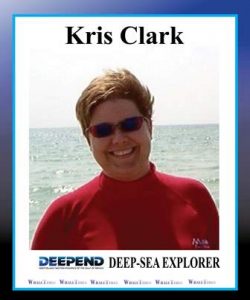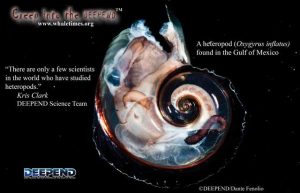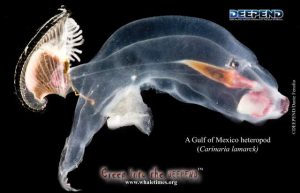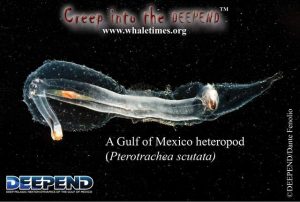Meet Kristine Clark, a graduate student at the University of South Florida-St. Petersburg. Kris is part of the DEEPEND Consortium studying the deep-sea in the Gulf of Mexico. Kris studies a kind of animal most people have never heard of – heteropods.
Hello Kris!
- Let’s jump in with this important clarification, you once said that heteropods “…are kind of like little globs of snot looking for other snot-like creatures to eat…” Does this mean they related to hagfish or they eat hagfish?
- KC: No, heteropods are not related in any way to hagfish. Hagfish are fish. Heteropods are invertebrates. To clarify my description, heteropods are just little gelatinous, floating balloons with eyes. Gorgeous, aren’t they?
- What is a heteropod?
- KC: Heteropods are open ocean (pelagic) marine snails. For those of you that like taxonomy, they are a kind of gastropod. There are different kinds of a heteropods:
- Atlantids: a fully-shelled group
- Carinarians: A Carinarian has a tiny little shell that only covers its visceral mass (which is about 1/10 of its body).
- Pterotrachids: These heteropods do not have a shell.
- Do you have a favorite kind of heteropod? Why?
- KC: I really find all of them very interesting. However, I do have a favorite. The Pterotrachids, especially a species called Pterotrachea scutata. (The name rolls off your tongue, doesn’t it?) They are little chubby, elongated, adorable looking heteropods!
- What makes heteropods standout enough to make it a Hagfish Day Star?
- KC: Because they are soooo weird and unusual!
- I saw some heteropods and couldn’t tell which end was which. Is that normal?
- KC: I think that is very normal for many people, especially when you see them for the first time. But, with a quick anatomy lesson, it is easy to see their head end versus their tail end. The Pterotrachids, for example, resemble little floating elephants. They have an elongated proboscis that looks like a tiny elephant’s trunk with a thicker collar at the distal end that forms their actual mouth.
- How do they catch their food/eat?
- KC: It depends on the kind of heteropod. Some have a sucker on their fin. They attach to the prey. Others just attach to prey with their radula. That’s a tongue-tooth combo gastropods have. Then they chew and swallow eating the whole prey, like another cool gastropod, the pteropod.
- What was your first thought when you heard that hagfish finally got their own holiday?
- KC: Hagfish?? Yucky! They are really weird and gross! Oh! I guess that makes for a very interesting animal! Now I get why they are awarded their own holiday! (A progressive thought process).
- How long have you been studying such cool creatures like the heteropods? Do you study them from shore, a ship, a sub?
- KC: I have been studying heteropods for 2.5 years. For DEEPEND, we mainly collect samples from cruises or out on ships. We do net tows from a ship far out at sea. We use a net system called the MOCNESS or MOC10. This net system is a series of five (5) nets that collects at determined depths. For example, Net 1 will open (deploy) at 1500 to 1200 meters below the surface of the ocean while all the other nets are closed. After about 2 hours, Net 1 closes. Then we raise the MOCNESS up to 1000 to 800 meters and Net 2 opens, and so on with all the nets. It is an awesome piece of equipment.
- What is your goal or how will your research help hagfish, dragonfish, and other ocean animals?
- KC: The more we know about heteropods the better we will understand how they fit into food web, ecosystem and how they interact with other ocean animals. The abundance of heteropods in the oceans is very large. That probably means many marine animals depend on them in some way. I am excited to find out how.
- Do heteropods need to be protected like whales and sharks?
- KC: As far as I can tell, heteropods do not require inclusion to any endangered lists any time soon. However! The overall health and status of the ocean is in crisis. There is not a clear understanding of how broad-scale phenomena as climate change to pollution will change life for heteropods. It does seem reasonable to assume that all life is being effected by temperature rises, ocean acidification, and the like. Especially for Atlantid and Carinaria heteropod species because they have shells. These creatures are effected by pH and chemical balance changes occurring in our oceans now. The overall effects are not known though. I hope with the DEEPEND research (and other scientists’) that knowledge will not come too late.
- How can I support (and/or follow) your research?
- KC: Celebrating Hagfish Day is a perfect way because it introduces unusual ocean animals and shares the importance of ocean research and protecting the ocean. As we all know in science circles, we have only explored about 5% of the ocean. There is so much more to discover!
- You can follow our research at the DEEPEND website: http://www.deependconsortium.org/
- What do you want/hope kids to learn/discover while they celebrate Hagfish Day?
- KC: I hope they discover a passion and drive for a lifetime of always learning,… a love and sensitive conscience for our marine environments,… and the beginnings of a personal responsibility to do all we can to protect and allow learning about them to fulfill.
- One last, and very important question. Dr. Douglas Fudge (one of our wonderful Hagfish Experts from a previous year) is trying to create fabric from hagfish slime. What do you think about that? Will wearing slime shirt make you the envy of the DEEPEND Team?
- KC: If he can figure that out, I want one! I will take a medium t-shirt please!
*If you’re wondering when you can get your hagfish inspired slime clothing, read our interview with Dr. Douglas Fudge or our article, “Save the Planet, Wear Hagfish Slime”



